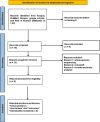Genetic Rearrangements in Different Salivary Gland Tumors: A Systematic Review
- PMID: 38966479
- PMCID: PMC11223175
- DOI: 10.7759/cureus.61639
Genetic Rearrangements in Different Salivary Gland Tumors: A Systematic Review
Abstract
Salivary gland tumors (SGT) encompass a wide range of neoplasms, each with its own unique histological type and clinical presentation. This review hones in on prevalent subtypes of SGTs, including adenoid cystic carcinoma (ACC), salivary duct carcinoma (SDC), and polymorphous adenocarcinoma (PAC). The articles, identified through specific keywords, were meticulously screened in databases like PubMed, Scopus, Google Scholar, and Web of Science from 2018 to 2023. Eight articles delved into genetic modifications among the selected SGT types. A fusion protein known as MYB-NF1B is typically associated with ACC, promoting cell proliferation while inhibiting apoptosis. The presence of MYB modifications in ACCs is a beacon of hope, as it is linked to a more favorable prognosis. In contrast, SDCs often exhibit HER2 expression. The invasive nature of SGTs contributes to their resistance to treatment. In the case of PAC, the role of PRKD1 is particularly noteworthy. PRKD1, integrated with other genes from the PRKD1/2/3 cluster, helps to differentiate PAC from other diseases. Furthermore, the genetic profiles of KTN1-PRKD1) and PPP2R2A:PRKD1 are distinct. The significant genetic variability among SGTs necessitates meticulous examination. This field is in a constant state of evolution, with new discoveries reshaping our understanding. Genetics is a key player in deciphering SGTs and tailoring treatments. This complex neoplasm demands ongoing research to uncover all genetic influences, thereby enhancing diagnostic methodologies, therapeutic strategies, and patient outcomes.
Keywords: adenoid cystic carcinoma; ktn1-prkd1; myb-nf1b; polymorphous adenocarcinoma; ppp2r2a::prkd1; salivary duct carcinoma; salivary gland tumors.
Copyright © 2024, Albalawi et al.
Conflict of interest statement
Conflicts of interest: In compliance with the ICMJE uniform disclosure form, all authors declare the following: Payment/services info: All authors have declared that no financial support was received from any organization for the submitted work. Financial relationships: All authors have declared that they have no financial relationships at present or within the previous three years with any organizations that might have an interest in the submitted work. Other relationships: All authors have declared that there are no other relationships or activities that could appear to have influenced the submitted work.
Figures
Similar articles
-
The PRKD1 E710D hotspot mutation is highly specific in separating polymorphous adenocarcinoma of the palate from adenoid cystic carcinoma and pleomorphic adenoma on FNA.Cancer Cytopathol. 2018 Apr;126(4):275-281. doi: 10.1002/cncy.21959. Epub 2017 Dec 20. Cancer Cytopathol. 2018. PMID: 29266837
-
The Role of Molecular Testing in the Differential Diagnosis of Salivary Gland Carcinomas.Am J Surg Pathol. 2018 Feb;42(2):e11-e27. doi: 10.1097/PAS.0000000000000980. Am J Surg Pathol. 2018. PMID: 29076877 Review.
-
Histologic spectrum of polymorphous adenocarcinoma of the salivary gland harbor genetic alterations affecting PRKD genes.Mod Pathol. 2020 Jan;33(1):65-73. doi: 10.1038/s41379-019-0351-4. Epub 2019 Sep 6. Mod Pathol. 2020. PMID: 31492931 Free PMC article.
-
A novel PPP2R2A::PRKD1 fusion in a cribriform adenocarcinoma of salivary gland.Genes Chromosomes Cancer. 2023 May;62(5):297-300. doi: 10.1002/gcc.23122. Epub 2023 Feb 3. Genes Chromosomes Cancer. 2023. PMID: 36625487
-
Polymorphous adenocarcinoma: an overview of immunohistochemical features and insights on molecular pathology.Histol Histopathol. 2019 Jul;34(7):731-744. doi: 10.14670/HH-18-089. Epub 2019 Feb 6. Histol Histopathol. 2019. PMID: 30723885 Review.
References
-
- Current status of histogenetic and morphogenetic concepts of salivary gland tumorigenesis. Dardick I, Burford-Mason AP. Crit Rev Oral Biol Med. 1993;4:639–677. - PubMed
-
- Don't stop the champions of research now: a brief history of head and neck pathology developments. Thompson LD, Lewis JS Jr, Skálová A, Bishop JA. Hum Pathol. 2020;95:1–23. - PubMed
Publication types
LinkOut - more resources
Full Text Sources
Research Materials
Miscellaneous

